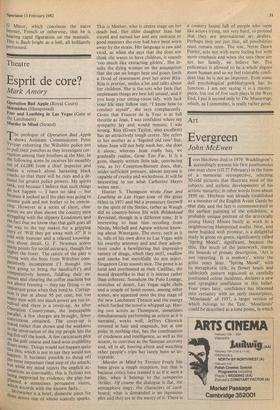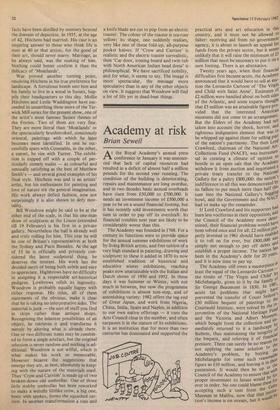Art
Evergreen
John McEwen
Ivon Hitchens died in 1979. Waddington's accordingly present his first posthumous one-man show (till 27 February) in the form of a memorial retrospective, selecting 30-odd pictures that illustrate most of the subjects and stylistic developments of his artistic maturity; in other words from about 1930 on. Hitchens was already established as a member of the English Avant Garde by that date and the fact is commemorated in the earliest painting of the exhibition, a probably unique portrait of the artistically young Henry Moore busily at work in a neighbouring Hampstead studio. Next, and more budded with promise, is a delightful study in green on green, significantly called `Spring Mood'; significant, because the title, like much of the paintwork, bursts the bounds of prosaic description. 'Art is not reporting. It is memory', wrote the artist years later. 'Spring Mood', with its metaphoric title, its flower heads and tablecloth pattern registered as carefully positioned colour incidents, declares a new and springlike confidence in this belief. Four years later, confidence has bloomed into certainty with an early masterpiece, `Moatlands' of 1937, a larger version of which belongs to the Tate. 'Moatlands' could be described as a tone poem, in which
facts have been distilled by memory beyond the domain of depiction. In 1935, at the age of 42, Hitchens had married. His case is an inspiring answer to those who think life is over at 40 or that artists, for the good of their art, should never marry. Marriage, as he always said, was the making of him. Nothing could better confirm it than the delicacy of 'Moatlands'.
War proved another turning point, resolving Hitchens in his true preference for landscape. A fortuitous bomb sent him and his family to live in a wood in Sussex, hap- pily their headquarters to this day. Mollie Hitchens and Leslie Waddington have suc- ceeded in unearthing three more of the Ter- wick Mill series for the present show, one of the artist's most famous Sussex themes of the Forties. Two of them are very fine. They are more literal than 'Moatlands' or the spectacularly brushstroked, consciously oriental, paintings with which he later becomes most identified. In one he suc- cessfully spars with Constable, in the other, a sunset, he vies with Turner. The exhibi- tion is topped off with a couple of par- ticularly comely nudes — as colourful and sensually satisfying as the best of Matthew Smith's — and several good examples of his final style. Hitchens was and is an artists' artist, but his enthusiasm for painting and love of nature stir the general imagination. His work always defied fashion, now not surprisingly it is also shown to defy mor- tality.
Bill Woodrow might be said to be at the other end of the scale, in that his one-man show of sculptures at the Lisson (extended till 19 February) is his first in a private gallery. Nevertheless the ball is already well and truly rolling for him. This year he will be one of Britain's representatives at both the Sydney and Paris Bienales. At the age of 33 he is officially and privately con- sidered the latest sculptural thing. he deserves the interest. His work has the decided merit of being both subtle and easy to appreciate. Highbrows have no difficulty in assigning it a respectable art-historical pedigree. Lowbrows relish its ingenuity. Woodrow is probably equally happy with either response. His titles, all of them statements of the obvious, make it clear that he is taking no interpretative sides. The material is junk — the sort of stuff you find in skips rather than antique shops. Recognising the inherent possibilities of an object, he retrieves it and transforms it merely by altering what is already there. One or two different items may be combin- ed to form a single artefact, but the original selection is never random and nothing is ad- ditional. Woodrow is not wilful, which is what makes his work so memorable. However bizarre the suggestions that emerge they are, at best, absolutely in keep- ing with the nature of the materials used. Thus `Crow and Carrion' is made up of two broken-down old umbrellas. One of those little stubby umbrellas has been reworked to make a weirdly lifelike crow, a big one, bony with spokes, forms the squashed car- rion. In another transformation a rose and a knife blade are cut to pop from an electric toaster. The colour of the toaster is tea-rose yellow; its shape, one suddenly realises, very like one of those fold-up, all-purpose pocket knives. If 'Crow and Carrion' is realistic and the electric toaster surrealistic, then 'Car door, ironing board and twin tub with North American Indian head dress' is philosophical. We have sacrificed nobility, and for what, it seems to say. The image is more spectacular, the message more speculative than in any of the other objects on view. It suggests that Woodrow will find a lot of life yet in dead-beat things.











































 Previous page
Previous page